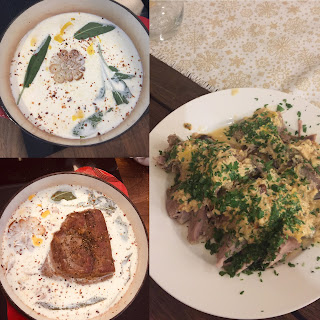 |
| Mastering the elements of good cooking! |
This is not "your typical cookbook". Colourful charts and whimsical
illustrations (rather than photographs to free the reader from the idea
that there's only one perfect image for every dish!). The hows and whys content truly reflect Samin's energetic and creative self!
Menu
Pasta alla Puttanesca
Salad of Roasted Beet, Preserved Lemon and Tahini-Yogurt
—with Smoked Mackerel
—with Smoked Mackerel
Maiale al Latte with Roasted Squash, Sage and Hazelnut Panzanella
 |
| Samin's Pasta alla Puttanesca |
I settled on Samin’s own recipe for Pasta alla Puttanesca to showcase layering of salt in a dish. This Italian classic features salt in several guises — anchovies, capers, olives and (optional) parmigiana — each delicious in small doses. All together, all at once, they make a big statement. Huge umami delicious, salty statement.
Having spent the last 30 years searching for ways to reduce my salt intake, drawing Salt as my assignment was a challenge. Yes, of course I agree that salt is essential in good cooking, the basic seasoning for pretty much everything. But little goes a long way. I experimented for a month, following Samin’s directions but never quite got the knack of it. I found her approach with salt way too heavy handed and will return to using the salt grinder, shaker and a measuring spoon.
There’s nothing subtle about Pasta alla Puttanesca, so a bold wine is in order. California’s Seven Deadly Zins was up to the task. A rustic Primotivo from Puglia would be equally appropriate.
 |
| California's Seven Deadly Zins Old Vine Zinfandel! |
Caroline | ACID
"Acid is salt's alter ego. While salt enhances flavours, acid balances them."
Roasted beets with preserved lemon and tahini-yogurt from our beloved Ottolenghi's Simple (and he's on my menu two nights this week)! The preserved lemon and tahini-yogurt blanket the roasted beets with layers of acidity. As per the chef's recommendation, I serve this with a smoked mackerel. Wine pairings are Sancerre -- Henri Bourgeois Les Baronnes and a Mailly Exception Blanche Grand Cru Brut Champagne 2007! After all, Christmas is just around the corner. The acid component of the salad pair well with the Sancerre and highlight the wines butteriness. The Champagne takes the smoked mackerel to heaven! Interesting exercise in pairing.
 |
| Roasted beets with preserved lemon and tahini-yogurt |
Diane
Michael Pollan, one of my favourite food
writers, wrote the introduction to the book Salt, Fat, Acid, Heat, and
revealed Samin gave him some cooking lessons after she attended his
class on food writing. His observations on sauteing an onion: "...there
was an intricate evolution unfolding in that pan as the rectangles of
onion went from crisply acidic to clean and sweet to faintly smokey as
they caramelized and then bittered slightly as they browned. Samin
showed me how half a dozen distinct flavours could be teased from that
humble ingredient, all depending on how you managed principle number
four, heat."
That insight motivated me to buy a copy of Samin's book and choose the element of Heat for the Epitourist feast.
At
the end of every one of her Heat classes, Samin shares a finished
braise with her students. The book dedicates more than a few pages on
classic braises and stews from around the world, however the dish I
ended up preparing was a braise of pork in milk: Maiale al Latte,
as it seemed we were trending to Italian flavours. Slow cooked over two
and a half hours, the aromas wafting from the oven created a wonderful
background to festivities.
 | ||
| Maiale al Latte! |
Laura
I really enjoyed
this month’s theme, which diverted from our usual focus on regional
cuisine. All four of us really enjoyed Samin Nostrat’s Netflix series
and wanted to delve more into the themes and recipes.
I was tasked with exploring fat. In her book, Salt, Fat, Acid, Heat Samin
writes, “Fat adds its own unique flavor to a dish, and it can amplify
the other flavors in a recipe. Simply put, fat makes food delicious—and
one of the most important things any cook can learn is how to harness
its magic.” I wanted to explore this idea by detouring from the obvious
meat fat. I chose to make a salad and focus on using butter instead of
oil in the dressing. I wanted to make a hearty salad that would reflect
the season as well as working well as a side dish, so I chose her
Roasted Squash, Sage and Hazelnut Panzanella. Browning the butter adds
another element to the flavour of the fat, and it stands up well to the
bold flavours in the salad. The recipe for the croutons and vinaigrette
is here https://www.cbc.ca/news/
 |
| Roasted Squash, Sage and Hazelnut Panzanella |
Caroline
As this was a sleepover dinner, dessert was in order. I stick to my assigned element and opt for an Amalfi Lemon Tart from Oliver's Jamie Cooks Italy. The crust calls for 1/3 cup of Greco di Tufo white wine. It is a new wine for us. And as Jamie suggests: "If you're feeling the Italian vibe, a little slice for breakfast with a black coffee is a real treat." And so, the next day for breakfast, a little tart was enjoyed with an expresso and a tasting of the Greco di Tufo.








































